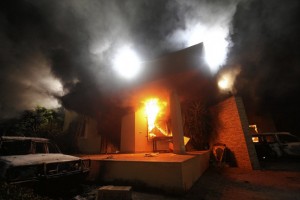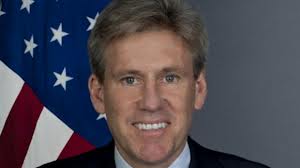 The US State Department suffered from “systemic failures” in its response to the terrorist threat in Benghazi, Libya, and had insufficient numbers of security on the ground, according to an independent panel investigating the Sept. 11 attack on the U.S. consulate there.
The US State Department suffered from “systemic failures” in its response to the terrorist threat in Benghazi, Libya, and had insufficient numbers of security on the ground, according to an independent panel investigating the Sept. 11 attack on the U.S. consulate there.
The report confirms that intelligence agencies and the White House erred in initial accounts that the assault in Libya sprang from public outrage against a U.S.-made anti-Islamic video, and is likely to rekindle Republican criticism about the administration’s handling of the attack, which was a key issue in the weeks leading into the Nov. 6 presidential election.
The Accountability Review Board study, conducted by a board appointed by Secretary of State Hillary Clinton and led by Adm. Mike Mullen, a retired top Pentagon official, and Thomas Pickering, a longtime U.S. diplomat, faulted a “lack of proactive senior leadership” for security in Benghazi, and said physical security was “profoundly weak.”
“Americans in Benghazi and their Tripoli colleagues did their best with what they had, which, in the end, was not enough to prevent the loss of lives,” the nearly 40-page report concludes. U.S. Ambassador Christopher Stevens and three other Americans were killed in the assault.
Mrs. Clinton said in a letter to Congress that the State Department would increase funding for security in overseas missions, hire more diplomatic security, and create a new office focused on high-threat postings.
“It is our responsibility to constantly improve, to reduce the risks our people face, and to make sure that they have the resources they need to do their jobs,” Mrs. Clinton said.
The study confirmed there had been security threats in Benghazi in the weeks leading up to the Sept. 11 attack on the U.S. consulate in the city, and its nearby annex.
 The investigation, however, said the U.S. had little understanding of the militias in Benghazi and did not act to improve security. Still, the report found no warning prior to the attacks that was missed by intelligence agencies.
The investigation, however, said the U.S. had little understanding of the militias in Benghazi and did not act to improve security. Still, the report found no warning prior to the attacks that was missed by intelligence agencies.
The report specifically said that the State Department relied too heavily on Libyan security guards to secure the post— despite the fact that U.S. officials had questioned the loyalty of some of these guards and that some had gone on strike for higher wages in the weeks before the attack.
“The Board found the Libyan government’s response to be profoundly lacking on the night of the attacks, reflecting both weak capacity and near absence of central government influence,” the report said.
That view has been borne out by officials who have described images contained in grainy nighttime surveillance video. Just minutes before an armed mob descended upon the American mission in Benghazi, Libya, a local police truck can be seen speeding away, according to U.S. investigators who have seen the footage.
The scene, captured by a camera outside the facility’s front gate, crystallizes what investigators now call a flaw in the U.S. security arrangement—the reliance on police, local security guards and contractors to protect the mission.
Congress plans hearings on Thursday that will examine how well the State Department protected the mission, along with its ability to protect other U.S. embassies and consulates around the world from future attacks.
In one of the most dangerous corners of the world, U.S. security in Benghazi depended in large part on three armed members of a militia sent by the government and four unarmed private guards.
“You’re not even sure what the loyalties of the local security forces or the local government are,” Sen. Susan Collins (R., Maine), the top Republican on the Senate Homeland Security and Governmental Affairs Committee, which is investigating the attacks, said in an interview. “We’ve got to have more protection for diplomatic personnel.”
President Barack Obama praised the response of Libyan security forces in a statement a day after the Sept. 11 assault on the mission.
But State Department and congressional investigators say they have since concluded that the protection provided by local Libyan forces was inadequate.
Libyan political and security officials disagree. They say that neither Ambassador Stevens nor the U.S. Embassy in Tripoli informed them of the ambassador’s travel plans ahead of his trip to Benghazi, and that security guard levels were in compliance with previous U.S. requests.
The State Department has testified before Congress that its protection plan matched the threats identified in Benghazi before the assault.
Diplomats relied upon a backup security force at a nearby annex occupied by the Central Intelligence Agency, and they sized the mission security force with that in mind, said officials familiar with State Department planning. CIA personnel responded to the assault, but arrived 50 minutes after the attack began and couldn’t save Ambassador Stevens or his colleague.
At the time of the Sept. 11, attack, only one of the three militia members was on guard outside the 13-acre compound. The other two were inside, and all were under orders not to return fire because they were outgunned and the crowd’s intent was unclear, according to U.S. and Libyan officials. The four private guards also were inside the compound. In addition, there were five American guards in the compound.
The roles of the various Libyan forces were so ill-defined that U.S. investigators are still working to understand who was in the police pickup truck, and whether they were affiliated with the guard detail at the mission.
The State Department has expanded its use of local contracting relationships to protect diplomats overseas, and is expected to become more reliant on such arrangements as the war in Afghanistan winds down.
But recommendations from the Accountability Review Board and other investigations into Benghazi are likely to call for changes in U.S. diplomatic security around the world, especially in high-threat locations, officials and lawmakers believe.
By law, the State Department is required to award local security contracts to the lowest “technically acceptable” bidder, except in Iraq, Afghanistan and Pakistan.
International diplomatic conventions also require host countries to provide guards for foreign emissaries and their missions, and the U.S. relies on foreign governments for diplomatic security world-wide.
The State Department’s inspector general found earlier this year that two-thirds of 86 diplomatic posts surveyed reported problems with local security, including insufficient numbers of guards and inadequate training.
Libya stands out as an unusual case, given the role of the militia members used to guard the mission. In Egypt and other Arab Spring countries, the government security forces largely survived intact.
Other options for security in Libya—deploying U.S. military personnel or a more robust professional diplomatic security team—were rejected by Ambassador Stevens and others, because they wanted to keep a low-key U.S. security profile, according to U.S. officials. State Department officials defended the decision, saying diplomats take risks to do their jobs around the world.
After Libyan dictator Moammar Gadhafi fell and the new U.S.-backed government of former rebels came to power, State Department officials believed they had little choice but to rely on largely untrained militia forces and unarmed private guards for protection.
The result was an arrangement with a British-Libyan security company called Blue Mountain. In Mr. Gadhafi’s time, this company also provided security to the U.S. embassy in Tripoli, and it remains the only private security company with a license to work in Libya. A Blue Mountain spokeswoman declined to comment, saying the company doesn’t comment on security issues.
Also providing security on behalf of the Libyan government was the militia, known as the Feb. 17 Brigade, which answers to Libya’s Interior Ministry. The Feb. 17 Brigade, named after the 2011 date marking the start of the Libyan revolution in Benghazi, also guards other national consulates in Benghazi, including the Egyptian posting.
American diplomats had grown increasingly wary of the Feb. 17 militia after an earlier incident in the Benghazi region within the past year in which Americans were detained despite having all the necessary diplomatic documents, a U.S. official said.
Eventually the Americans were released. The commander of the Feb 17 brigade called this incident a “misunderstanding” based on poorly trained guard members, not malice.
Mohammed Farraj was a 22-year-old shift leader for the Feb. 17 militia unit on guard at the U.S. mission on Sept. 11. He said in an interview that another Feb. 17 Brigade guard posted on the street outside the facility that evening told him, via his walkie-talkie, that a group of armed, bearded men were gathering outside the mission walls.
At 9:15 p.m., the commotion on the street was loud enough that Mr. Farraj told his two guards to move back inside the walled compound, according to Libyan officials. He said he alerted his superiors at the city’s security headquarters as well as the Americans.
Libyan security commanders ordered his unit not to engage with the mob, as they were afraid of escalating tensions before understanding the intentions of the group, according to two Libyan security officials on duty that night in Benghazi.
Within minutes, however, Mr. Farraj said that the compound was overrun, and the whole facility was overwhelmed with attackers. “They didn’t come to talk. They came to fight,” said Mr. Farraj.
No Libyans died in the two attacks that night, but 12 security guards, both those present at the mission and those called as backup to help evacuate the Americans first from the mission and then from Benghazi altogether, sustained gunshot and shrapnel injuries.
Officials say the mob was a mix of militants, local residents and looters. U.S. investigators believe they used diesel fuel canisters found at the scene to torch the facility, killing Mr. Stevens and another State Department official. Two other Americans were killed later at the CIA annex about a mile away.
Libyan guards say they helped search the burning compound for the ambassador and helped clear a route for U.S. officials to evacuate the facility. A senior Obama administration official said the local Libyan government wanted to help the Americans, but lacked the capability for doing so.
On the surveillance camera video, which was shown to lawmakers in a condensed form, a pickup truck identified by U.S. officials as belonging to a local Libyan police force can be seen leaving the facility’s main gate around 9:30 p.m.
But it is unclear from the footage how many security men were in the pickup, said those who have seen it.
Officials said the working theory for American investigators is that the security men in the pickup truck were members of a local Libyan police force who fled when they saw the heavily armed mob approaching the facility.
Libyan security commanders say they cannot confirm who was driving this vehicle, but they are confident that the driver wasn’t part of the guard detail that evening.
None of the three Feb. 17 Brigade militia members fired a shot, according to U.S. and Libyan accounts. At least one is shown in other surveillance footage obtained by the Americans getting beaten by attackers who breached the compound’s walls, officials said.
State Department officials say the Blue Mountain guards were unarmed because of a Libyan government requirement. Sen. Collins questioned why the U.S. would agree to such a demand, especially in a country awash in weapons. “It’s like they are the only ones in the country without arms,” she said.
WSJ
Leave a Reply
You must be logged in to post a comment.